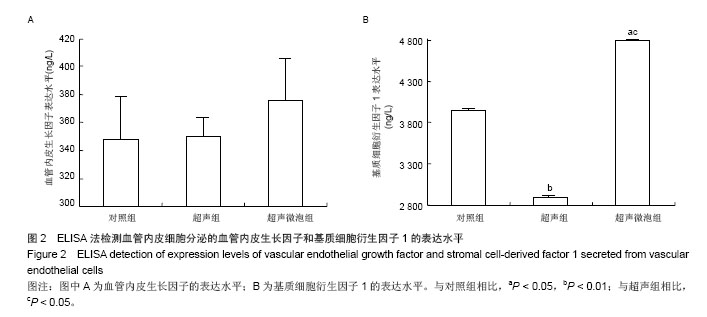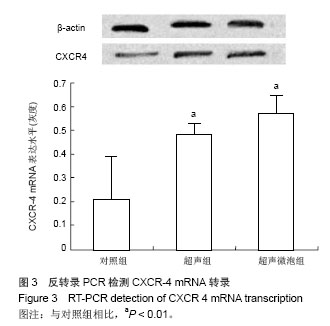| [1]陈利娟,李承宴.亚低温对外源性骨髓基质细胞迁移、增殖的影响[J].武汉大学学报,2008,29(1):95-97.
[2]Imada T, Tatsumi T, Mori Y, et al. Targeted delivery of bone marrow mononuclear cells by ultrasound destruction of microbubbles induces both angiogenesis and arteriogenesis response. Arterioscler Thromb Vasc Biol. 2005;25(10): 2128-2134.
[3]Zen K, Okigaki M, Hosokawa Y, et al. Myocardium-targeted delivery of endothelial progenitor cells by ultrasound- mediated microbubble destruction improves cardiac function via an angiogenic response. J Mol Cell Cardiol. 2006;40(6): 799-809.
[4]童嘉毅,李金鹆,范国峰,等.超声波促骨髓间充质干细胞心肌内归巢的实验研究[J].中国心血管病研究,2008(10):771-773.
[5]Liu L, Eckert MA, Riazifar H, et al. From blood to the brain: can systemically transplanted mesenchymal stem cells cross the blood-brain barrier? Stem Cells Int. 2013;2013:435093.
[6]Liu HL, Wai YY, Hsu PH, et al. In vivo assessment of macrophage CNS infiltration during disruption of the blood-brain barrier with focused ultrasound: a magnetic resonance imaging study. J Cereb Blood Flow Metab. 2010; 30(1):177-186.
[7]童嘉毅,马根山,冯毅,等.超声波促骨髓间充质干细胞心肌内归巢的实验研究[J].中国心血管病研究杂志,2008,6(10):771-773.
[8]徐琢,冯毅,童嘉毅,等.超声微泡辅助干细胞移植治疗急性心肌梗死的实验研究[J].东南大学学报(医学版),2008,27(3):192-194.
[9]范国峰,冯毅,童嘉毅,等.超声联合微泡对内皮祖细胞体外增殖、凋亡及细胞周期的影响[J].东南大学学报(医学版),2009,30(2): 109-112.
[10]Lopez AD, Mathers CD, Ezzati M, et al. Global and regional burden of disease and risk factors, 2001: systematic analysis of population health data. Lancet. 2006;367(9524): 1747- 1757.
[11]Segers VF, Lee RT. Stem-cell therapy for cardiac disease. Nature. 2008;451(7181):937-942.
[12]Urbich C, Dimmeler S. Endothelial progenitor cells: characterization and role in vascular biology. Circ Res. 2004; 95(4):343-353.
[13]范国峰,沙杜鹃,徐鹏,等.超声联合微泡促进骨髓间充质干细胞迁移的实验研究[J].东南国防医药,2014,16(1):20-22.
[14]Karp JM, Leng Teo GS. Mesenchymal stem cell homing: the devil is in the details. Cell Stem Cell. 2009;4(3):206-216.
[15]Kitaori T, Ito H, Schwarz EM, et al. Stromal cell-derived factor 1/CXCR4 signaling is critical for the recruitment of mesenchymal stem cells to the fracture site during skeletal repair in a mouse model. Arthritis Rheum. 2009;60(3): 813-823.
[16]Ghadge SK, Mühlstedt S, Ozcelik C, et al. SDF-1α as a therapeutic stem cell homing factor in myocardial infarction. Pharmacol Ther. 2011n;129(1):97-108..
[17]Li M, Yu J, Li Y, et al. CXCR4 positive bone mesenchymal stem cells migrate to human endothelial cell stimulated by ox-LDL via SDF-1alpha/CXCR4 signaling axis. Exp Mol Pathol. 2010;88(2):250-255.
[18]Zhong S, Shu S, Wang Z, et al. Enhanced homing of mesenchymal stem cells to the ischemic myocardium by ultrasound-targeted microbubble destruction. Ultrasonics. 2012;52(2):281-286.
[19]Wynn RF, Hart CA, Corradi-Perini C, et al. A small proportion of mesenchymal stem cells strongly expresses functionally active CXCR4 receptor capable of promoting migration to bone marrow. Blood. 2004;104(9):2643-2645.
[20]van Weel V, Seghers L, de Vries MR, et al. Expression of vascular endothelial growth factor, stromal cell-derived factor-1, and CXCR4 in human limb muscle with acute and chronic ischemia. Arterioscler Thromb Vasc Biol. 2007; 27(6):1426-1432.
[21]Abbott JD, Huang Y, Liu D, et al. Stromal cell-derived factor-1alpha plays a critical role in stem cell recruitment to the heart after myocardial infarction but is not sufficient to induce homing in the absence of injury. Circulation. 2004; 110(21):3300-3305.
[22]De Falco E, Porcelli D, Torella AR, et al. SDF-1 involvement in endothelial phenotype and ischemia-induced recruitment of bone marrow progenitor cells. Blood. 2004;104(12): 3472- 3482.
[23]Kaminski A, Ma N, Donndorf P, Lindenblatt N, et al. Endothelial NOS is required for SDF-1alpha/CXCR4- mediated peripheral endothelial adhesion of c-kit+ bone marrow stem cells. Lab Invest. 2008; 88(1):58-69.
[24]Murohara T, Horowitz JR, Silver M, et al. Vascular endothelial growth factor/vascular permeability factor enhances vascular permeability via nitric oxide and prostacyclin. Circulation. 1998; 97(1):99-107. |



